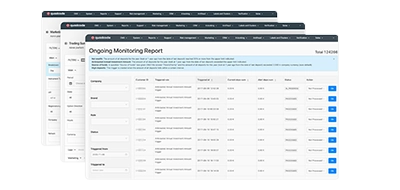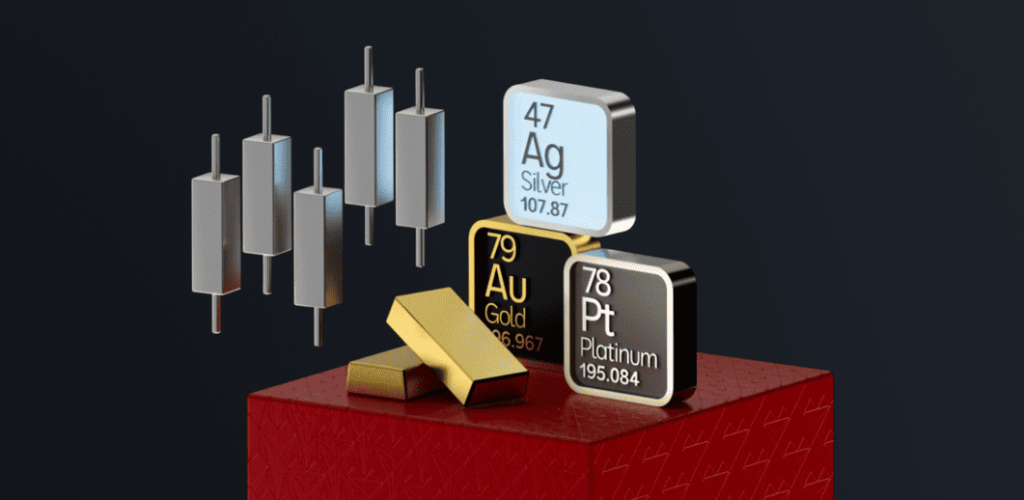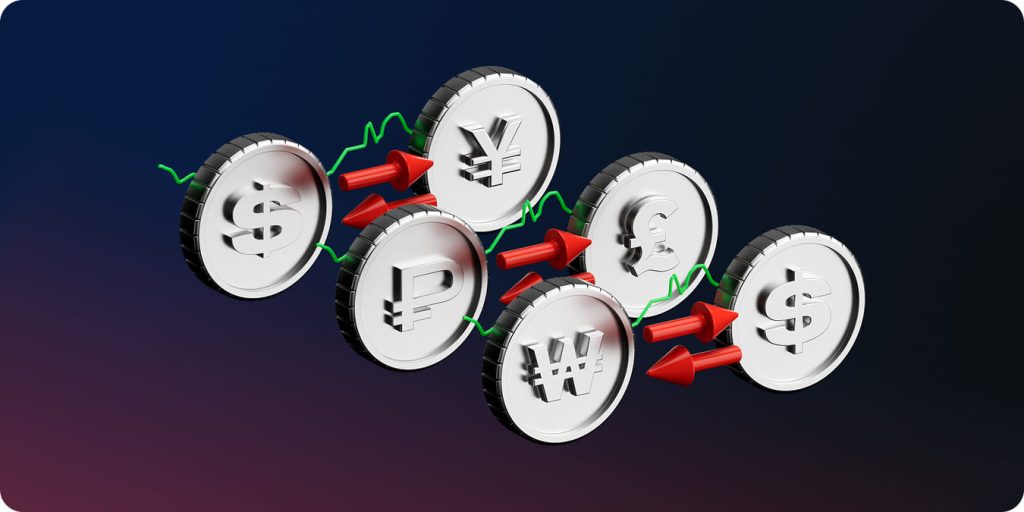Volver
Contents
Patrones triangulares en el trading: tu guía completa para dominar el análisis de gráficos


Demetris Makrides
Senior Business Development Manager

Vitaly Makarenko
Chief Commercial Officer
Los patrones triangulares son formaciones de consolidación que se forman cuando la acción del precio traza líneas de tendencia convergentes, creando una apariencia triangular en los gráficos. Permiten vislumbrar posibles direcciones de ruptura y puntos de entrada óptimos, lo que los convierte en herramientas prácticas tanto para operadores intradía como para operadores de swing.
¿Qué son los patrones triangulares?
Los patrones triangulares se forman cuando el rango de cotización de una acción o valor se contrae tras una tendencia alcista o bajista. Esto genera un período de consolidación donde compradores y vendedores se equilibran temporalmente antes del siguiente movimiento significativo de precios.
La belleza de los patrones triangulares reside en su naturaleza predictiva. Indican cuándo la indecisión del mercado está a punto de detenerse y en qué dirección se moverá el precio a continuación.
La psicología detrás de la formación de triángulos
Los patrones triangulares representan la lucha entre alcistas y bajistas. A medida que se desarrolla el patrón, cada máximo sucesivo es más bajo y cada mínimo sucesivo es más alto. Esta convergencia representa una volatilidad decreciente y una tensión creciente en el mercado.
En algún momento, un bando gana. La dirección de la ruptura suele depender de la tendencia subyacente, el estado de ánimo del mercado y los patrones de volumen en formación.
Los tres tipos más significativos de patrones triangulares
Patrón de triángulo ascendente
Un triángulo ascendente es un patrón de continuación alcista que se forma en las tendencias alcistas. Consiste en una línea de resistencia plana en la cima y una línea de soporte ascendente que conecta mínimos más altos.
Características principales:
- Línea de resistencia plana (línea plana)
- Línea de soporte ascendente (línea ligeramente inclinada)
- Disminuir el volumen de formación
- Inclinación alcista (60-70% de probabilidad de ruptura en dirección ascendente)
Proceso de formación:
- El precio toca la resistencia varias veces pero no la rompe.
- Los mínimos sucesivos son más altos que el anterior.
- Los compradores se vuelven más agresivos con cada rebote
- El volumen generalmente disminuye a medida que se desarrolla el patrón.
Estrategia comercial: Abra posiciones largas cuando el precio supere el nivel de resistencia con un mayor volumen. Establezca su stop loss por debajo del mínimo más reciente. Las distancias objetivo son iguales a la altura del punto más ancho del triángulo.
Patrón de triángulo descendente
El triángulo descendente es un patrón de continuación bajista que se forma en tendencias bajistas. Se caracteriza por una línea de soporte horizontal en la base y una línea de resistencia descendente que conecta máximos decrecientes.
Características principales:
- Nivel de soporte plano (línea horizontal)
- Nivel de resistencia descendente (línea descendente)
- Disminución del interés de compra
- Sesgo bajista (60-70% de probabilidad de ruptura a la baja)
Mecanismo de formación:
- El precio rebota desde el soporte varias veces
- Cada intento de rally produce un máximo más bajo
- Los vendedores se vuelven cada vez más agresivos con cada rebote
- Los patrones de volumen a menudo mostrarán una presión de venta creciente.
Estrategia comercial: Posición corta ante una ruptura del precio por debajo del nivel de soporte tras la confirmación. Coloque su stop loss en el máximo inferior más reciente. Los objetivos de beneficio deben ser iguales a la altura máxima del triángulo.
Patrón de triángulo simétrico
El triángulo simétrico es un patrón neutral que puede romperse al alza o a la baja. Se forma cuando los máximos y los mínimos convergen en el mismo punto, generando dos líneas de tendencia simétricas.
Características principales:
- Línea de resistencia descendente (que conecta máximos inferiores)
- Línea de soporte ascendente (que conecta mínimos más altos)
- Líneas de tendencia convergentes
- Sesgo neutral (probabilidad de ruptura 50-50)
Formación del patrón:
- El precio fluctúa entre líneas de tendencia convergentes
- Cada swing se hace cada vez más pequeño.
- La volatilidad disminuye a medida que se desarrolla el patrón.
- La ruptura generalmente ocurre en el tercio final del patrón.
Estrategia comercial: Espere una ruptura clara en cualquier dirección. Utilice la altura del triángulo para establecer objetivos de ganancias. La confirmación del volumen es crucial para la fiabilidad.
Ejemplos de variaciones avanzadas del patrón de triángulos
Triángulo en expansión (formación en ensanchamiento)
El triángulo en expansión es el inverso de un triángulo simétrico. Las líneas de tendencia divergen en lugar de converger, lo que genera oscilaciones de precios más amplias.
Características:
- Líneas de tendencia divergentes
- Aumento de la volatilidad
- Máximos más altos y mínimos más bajos
- A menudo indicativo de indecisión del mercado.
Consideraciones comerciales: Estas son más difíciles de operar debido a su mayor volatilidad. Utilice stop loss más amplios y posiciones más pequeñas. Busque las líneas de tendencia externas como posibles puntos de reversión.
Triángulo rectángulo
Los triángulos rectángulos se componen de una línea de tendencia horizontal y una línea de tendencia inclinada. Son esencialmente triángulos ascendentes o descendentes, pero con mayor sesgo direccional.
Solicitud de Trading: Los triángulos simétricos proporcionan menos información direccional que estos patrones. La línea horizontal es un nivel importante de soporte o resistencia que debe romperse para que el patrón concluya.
Cómo identificar patrones de triángulos válidos
Criterios críticos
Un patrón de triángulo solo será válido si cumple lo siguiente:
Requisitos de tiempo:
- El patrón debería desarrollarse a lo largo de semanas o meses.
- Debe tener no menos de cuatro puntos de contacto (dos en cada línea de tendencia)
- La ruptura debe ocurrir en el tercio final del patrón.
Patrones de volumen:
- El volumen debe disminuir durante la formación.
- La ruptura debe ocurrir con un volumen superior al promedio
- La confirmación del volumen solidifica la señal
Calidad de la línea de tendencia:
- Debe haber al menos dos puntos de contacto importantes para cada línea de tendencia.
- Debería haber un mínimo de falsas rupturas
Errores que ocurren en una formación común
- Forzando el patrón: No fuerce líneas de tendencia que no conecten de forma convincente máximos y mínimos importantes. El trazado subjetivo de líneas genera señales falsas.
- Ignorando el volumen: La acción del volumen es crucial para la confirmación del patrón triangular. Disminuir el volumen en la formación y aumentarlo en la ruptura aporta fuerza.
- Entrada prematura: Aprovecha las rupturas confirmadas en lugar de esperarlas. Las rupturas falsas son comunes, especialmente en el vértice del triángulo.
Cómo operar con patrones de triángulos de manera efectiva
Estrategias de entrada
- Método de ruptura: Espere a que el precio supere la resistencia (triángulo ascendente) o baje el soporte (triángulo descendente) con confirmación del volumen. Abra en cuanto se confirme el cierre de la vela de ruptura.
- Método de retroceso: Apertura tras un retroceso hacia la línea de tendencia rota tras la ruptura inicial. El método ofrece mejores ratios riesgo-beneficio, pero no es paciente.
- Método de anticipación: Entrar cerca de la línea de tendencia opuesta cuando el precio esté cerca de ella. Esta estrategia agresiva requiere un buen reconocimiento de patrones y una gestión rigurosa del riesgo.
Colocación de stop loss
- Enfoque conservador: Coloque stops fuera de la línea de tendencia opuesta en la dirección de entrada. Esto permite que el patrón funcione, pero requiere posiciones más grandes.
- Enfoque agresivo: Utilice stops más ajustados desde niveles de soporte/resistencia recientes. Este enfoque genera posiciones más grandes, pero con la posibilidad de stop-outs prematuros.
Objetivos de ganancias
- Objetivo mínimo: Utilice la altura del triángulo (en su parte más ancha) como objetivo mínimo de beneficio. Añádala al precio de ruptura.
- Objetivos ampliados: Busca la confluencia con otros niveles técnicos:
- Niveles de soporte/resistencia anteriores
- retrocesos de Fibonacci
- Números redondos
- Promedios móviles
Análisis de volumen en patrones triangulares
Características del volumen
Formación:
- El volumen debería ir disminuyendo a medida que avanza la tendencia.
- Un menor volumen indica indecisión del mercado
- Ocasionalmente se producirán aumentos intermitentes en el volumen en los contactos de la línea de tendencia.
En Breakout:
- El volumen debería ser mucho mayor en la ruptura.
- Un mayor volumen valida la autenticidad de la ruptura
- El volumen debe ser 50% superior al promedio reciente
Después de la fuga:
- El volumen puede disminuir después de la ruptura inicial.
- Los retrocesos deben realizarse con un volumen menor
- La nueva expansión de volumen valida los movimientos de continuación
Señales de divergencia de volumen
- Divergencia alcista: El precio crea mínimos más bajos, pero el volumen crea mínimos más altos, lo que sugiere un debilitamiento de la presión de venta y una posible ruptura al alza.
- Divergencia bajista: El precio alcanza máximos más altos, pero el volumen alcanza máximos más bajos, lo que sugiere un debilitamiento de la presión de compra y una posible ruptura a la baja.
Impacto de los patrones triangulares en diferentes mercados
Mercados Forex
Las formaciones triangulares son ideales en forex debido a su alta liquidez y al desarrollo de tendencias puro. Los triángulos en los principales pares de divisas suelen desarrollar formaciones triangulares definidas durante los períodos de consolidación.
Mejores prácticas:
- Tenga en cuenta los plazos de entrega más altos (4 horas diarias)
- Considere las noticias económicas que pueden afectar las rupturas
- Utilice un tamaño de posición adecuado para las fluctuaciones monetarias
Mercados de valores
Los índices bursátiles y las acciones individuales comúnmente producen formaciones triangulares cuando hay períodos de calma en las ganancias o cuando el mercado se está consolidando.
Consideraciones:
- Los anuncios de ganancias pueden generar rupturas.
- La rotación de sectores afecta la confiabilidad del patrón
- La capitalización de mercado influye en la importancia del patrón
Mercados de criptomonedas
Los mercados de criptomonedas muestran patrones triangulares claros debido a la volatilidad extrema y la actividad de tendencia activa.
Consideraciones especiales:
- El aumento de la volatilidad requiere mayores stops
- Los acontecimientos noticiosos pueden crear estallidos espectaculares
- El trading 24/7 crea dinámicas de patrones extrañas
Errores comunes en el patrón de triángulos
Errores de reconocimiento de patrones
- Forzando las líneas: No trace líneas de tendencia que no conecten máximos y mínimos importantes. La interpretación personal lleva a decisiones de trading deficientes.
- Ignorando el contexto: Examine la tendencia y las condiciones generales del mercado. Los patrones triangulares funcionan mejor en mercados con tendencia que en mercados volátiles y sin tendencia.
Errores de ejecución de operaciones
- Entrada anticipada: Entrar antes de las rupturas confirmadas aumenta la probabilidad de señales falsas. Utilice la confirmación adecuada antes de arriesgar capital.
- Mala gestión de riesgos: El uso de tamaños de posiciones inadecuados o la colocación de stop loss tiene el potencial de convertir patrones ganadores en operaciones perdedoras.
Problemas psicológicos
- Impaciencia: Los patrones triangulares requieren mucho tiempo para formarse y completarse. Las operaciones impulsivas suelen generar pérdidas.
- Exceso de seguridad: Incluso los patrones probables a veces fallan. Utilice una gestión de riesgos adecuada, independientemente de la calidad del patrón.
Cómo mejorar el análisis de patrones triangulares
Confirmación de múltiples períodos de tiempo
Verifique los patrones de triángulos en diferentes períodos de tiempo para verificar su validez:
Plazos más altos:
- Los gráficos diarios y semanales muestran patrones de triángulos grandes.
- Se da mayor importancia y énfasis a estos patrones.
- Las rupturas tienden a producir movimientos más grandes
Plazos inferiores:
- Los gráficos horarios ayudan a cronometrar entradas y salidas.
- Proporcionar señales de alerta temprana para brotes
- Ejemplos útiles para afinar la colocación del stop loss
Combinar con otros indicadores
Promedios móviles:
- Utilice las medias móviles para confirmar la dirección de la tendencia
- Observar la formación de patrones alrededor de niveles cruciales de MA
- Los cruces de MA se pueden utilizar para anticipar situaciones de ruptura
Indicadores de momentum:
- El RSI y el MACD pueden señalar divergencias
- Los cambios en el impulso generalmente resultan en rupturas.
- Las condiciones de sobrecompra/sobreventa afectan la confiabilidad del patrón
Soporte y resistencia:
- Etiquete los niveles clave que podrían afectar las divergencias
- Los niveles históricos añaden confluencia al análisis de patrones
- Los números redondos y los niveles psicológicos son significativos.
Gestión de riesgos para el trading triangular
Dimensionamiento de la posición
Calcular el tamaño de las posiciones en función de:
- Distancia a la entrada y stop loss
- Porcentaje de riesgo de la cuenta (normalmente entre el 1 y el 2 %)
- Factores de confiabilidad del patrón
Consideraciones de cartera
Diversificación:
- Evite operar con múltiples patrones de triángulos correlacionados.
- Distribuir el riesgo entre mercados y períodos de tiempo
- Considere la exposición general de la cartera
Análisis de correlación:
- Comprender cómo se correlacionan los diferentes mercados
- Evite la sobreexposición a patrones similares
- Equilibrar el sesgo direccional entre posiciones
Contexto del mercado y patrones triangulares
Análisis de tendencias
Patrones de continuación:
- Triángulos ascendentes en tendencias alcistas
- Triángulos descendentes en tendencias bajistas
- Más tasas de éxito si se conecta con la tendencia
Patrones de inversión:
- Triángulos en los extremos de la tendencia
- Indicaciones de divergencia de volumen
- Tasas de éxito más bajas pero movimientos potencialmente más grandes
Factores económicos
Eventos de noticias:
- Los triángulos bursátiles se ven afectados por la publicación de resultados
- Los triángulos de Forex se ven afectados por los informes económicos
- Los triángulos de mercado se ven afectados por las acciones de los bancos centrales
Patrones estacionales:
- Los períodos de vacaciones afectan el volumen y la volatilidad
- Patrones trimestrales en los mercados de valores
- Patrones mensuales en los mercados de divisas
Conclusión
Los patrones triangulares son una de las herramientas más fiables y universales del análisis técnico, ofreciendo puntos de entrada claros y oportunidades medibles de riesgo-recompensa. El éxito con estos patrones depende de una correcta identificación, la confirmación del volumen y la gestión del riesgo, y no de intentar operar con todos los patrones que se observan. Concéntrese en patrones de alta confianza que coincidan con la dirección general del mercado y espere siempre la confirmación de una ruptura antes de abrir posiciones.
A medida que domine sus habilidades, descubrirá que los patrones triangulares son una parte clave de su plan de trading, ayudándole a navegar las consolidaciones del mercado y a aprovechar los movimientos explosivos que suelen seguir. Recuerde que la paciencia y la persistencia le serán más útiles que intentar forzar las operaciones con patrones marginales.
FAQ
Los patrones triangulares suelen requerir semanas o meses. El patrón debe tener al menos cuatro puntos de contacto (dos en cada línea de tendencia) y una duración suficiente para ser significativo. Los patrones que no duran lo suficiente (días) tienden a ser poco fiables.
Los triángulos tienen líneas de tendencia convergentes, pero por lo demás presentan una pendiente generalmente horizontal, mientras que las cuñas se inclinan en la dirección de la tendencia. Los triángulos son principalmente patrones de continuación, mientras que las cuñas suelen indicar el agotamiento de la tendencia.
Sí, los patrones triangulares pueden fallar como cualquier otro patrón técnico. Las falsas rupturas ocurren cuando el precio rompe una línea de tendencia, pero se revierte en un corto periodo. Por eso, la confirmación del volumen y una gestión adecuada del riesgo son esenciales.
El mejor marco temporal depende de su preferencia. Los day traders pueden operar con gráficos de 15 minutos a 1 hora, mientras que los swing traders operan con gráficos de 4 horas a diarios. En promedio, los patrones en marcos temporales más amplios son más sólidos.
Actualizado:
14 de julio de 2025




